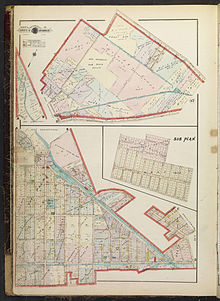Palms-Southern Pacific Railroad Depot
Palms | |||||||||||||||||||||
|---|---|---|---|---|---|---|---|---|---|---|---|---|---|---|---|---|---|---|---|---|---|
 Palms Depot | |||||||||||||||||||||
| History | |||||||||||||||||||||
| Opened | c. 1886–1888 | ||||||||||||||||||||
| Services | |||||||||||||||||||||
| |||||||||||||||||||||
| Location | Heritage Square, 3800 N. Homer St., Montecito Heights, Los Angeles, California, USA | ||||||||||||||||||||
| Coordinates | 34°5′17.5″N 118°12′28.5″W / 34.088194°N 118.207917°W | ||||||||||||||||||||
| Governing body | Heritage Square | ||||||||||||||||||||
| Designated | 1963[1] | ||||||||||||||||||||
| Reference no. | 22 | ||||||||||||||||||||
Palms-Southern Pacific Railroad Depot is a historic railroad depot built between 1886 and 1888 in what is now the Palms section of Los Angeles, California.[2][3] The two-story wood depot was originally located at the corner of National Boulevard and Vinton Avenue.[3]
In 1928, an “old-timer” told the Los Angeles Times that decades before the Palms station had been known as “Grasshopper Station” because at the time “grasshoppers were present in veritable clouds.”[4] The Southern Pacific later changed the station's name to “The Palms”, and the surrounding community adopted the name.[2] As one of only two depots on the fifteen-mile route between Los Angeles and Santa Monica (the other being the Ivy station in Culver City), the Palms Depot served as the hub of a growing agricultural community.[5]
From the 1920s to the 1940s, the motion picture business became the dominant business in the Palms-Culver City area, and movie stars, including Clark Gable, could be seen getting off the Red Cars on their way to work at the nearby studios.[2]
In 1953, the Red Car line was shut down, and the depot was abandoned.[2] As the surrounding area became a suburban residential community, the depot became “a symbol of another day and reflective of what has happened to Palms”.[5]
In the early 1960s, the Culver-Palms Boy Scout Troop 49 undertook a beautification of the depot building and used it as a meeting place.[3] The Los Angeles Cultural Heritage Board declared the building to be a Los Angeles Historic-Cultural Monument in 1963; it was the 22nd structure to receive the historic monument designation. Despite the designation, the depot remained vacant, was victimized by vandals and graffiti, and fell into serious disrepair in the early 1970s.[2]

The Los Angeles Fire Department ultimately condemned the structure, but preservationists sought to save it from demolition. In 1976, the Los Angeles Cultural Heritage Foundation raised funds to move the structure to Heritage Square Museum in Montecito Heights.[2] The depot presently sits at the entrance to Heritage Square and houses the museum gift shop.
See also
[edit]References
[edit]- ^ Los Angeles Department of City Planning (September 7, 2007). "Historic - Cultural Monuments (HCM) Listing: City Declared Monuments" (PDF). City of Los Angeles.
{{cite journal}}: Cite journal requires|journal=(help) - ^ a b c d e f Harvey, Steve (February 5, 1976). "End of the Line? Not for the 'Grasshopper Stop'; Fund-Raising Drive Saves Palms Depot; It's On To Heritage Square". Los Angeles Times.
- ^ a b c "1888 Depot in Palms Declared a Monument". Los Angeles Times. September 8, 1963.
- ^ Guzman, N.S. (March 4, 1928). "Rancho Days of Past Recalled". Los Angeles Times. p. 33 – via Newspapers.com.

- ^ a b "Palms Losing Identity, Calm Life". Los Angeles Times. July 24, 1966.
